 VP-61 History VP-61 History
Circa 1949
 A BIT OF HISTORY: A BIT OF HISTORY:  "...Photo Unit Flies Long Hops - Page 27 - Naval Aviation News - October 1949..." WebSite: http://www.history.navy.mil/nan/backissues/1940s/1949/oct49.pdf [13JUL2004] "...Photo Unit Flies Long Hops - Page 27 - Naval Aviation News - October 1949..." WebSite: http://www.history.navy.mil/nan/backissues/1940s/1949/oct49.pdf [13JUL2004]

 A BIT OF HISTORY: A BIT OF HISTORY:  "...Navy Maps Alaska Oil - Page - 12 - Naval Aviation News - August 1949..." WebSite: http://www.history.navy.mil/nan/backissues/1940s/1949/aug49 [12JUL2004] "...Navy Maps Alaska Oil - Page - 12 - Naval Aviation News - August 1949..." WebSite: http://www.history.navy.mil/nan/backissues/1940s/1949/aug49 [12JUL2004]
 
 A BIT OF HISTORY: A BIT OF HISTORY:  "..."Old Reliable" Libs Honored- Page 20 - Naval Aviation News - March 1949..." WebSite: http://www.history.navy.mil/nan/backissues/1940s/1949/mar49.pdf [15JUL2004] "..."Old Reliable" Libs Honored- Page 20 - Naval Aviation News - March 1949..." WebSite: http://www.history.navy.mil/nan/backissues/1940s/1949/mar49.pdf [15JUL2004]

Circa 1948
 A BIT OF HISTORY: "...AERIAL SURVEY OF NORTHERN ALASKA IN 1948..." Contributed by Frank Breitenstein fvbreit@yahoo.com [18AUG2000] A BIT OF HISTORY: "...AERIAL SURVEY OF NORTHERN ALASKA IN 1948..." Contributed by Frank Breitenstein fvbreit@yahoo.com [18AUG2000]
AERIAL SURVEY OF NORTHERN ALASKA IN 1948
On 24 April 1948, Photographic Squadron ONE (VPP-1) commensed deployment of six PB4Y-1P (Liberators) and two SNB (Beechcraft) and flight and ground personnel from the N.A.A.S. Miramar to the Big Delta Air Base and Umiat, Alaska. The primary mission was to map the Naval Petrolium Reserve FOUR (NPR-4) in northern Alaska. One Liberator was deployed to Marks Air Force Base, Nome, Alaska, to conduct an aerial survey of St. Matthew and St. Lawrence Islands in the Bering Sea.
While awaiting the snow cover to thaw in the NPR-4 area, VPP-1 conducted an aerial survey of the proposed oil pipeline strip between Fairbanks and northern Alaska. (The pipeline was built about 25 years later.) By the middle of June, the NPR-4 area was free of snow and aerial mapping of the petrolium reserve was commenced.
During this deployment, on 2 September 1948, the designation of Photographic Squadron ONE (VPP-1) was changed to Patrol Squadron SIXTY ONE (VP-61).
In early September, when weather over the NPR-4 was poor, VP-61 assisted the U.S. Air Force Alaskan Air Command in a photographic mapping project in the vicinity of Fairbanks and the Richardson Highway.
By the end of September 1948, with snow covering most of the NPR-4 region and poor photographic weather prevailing over most of Alaska, VP-61 was ordered to return to its home port in California. Squadron aircraft departed Alaska for N.A.A.S. Miramar by way of the inland route--Edmonton, Canada, Great Falls, Montana, and Salt Lake City, Utah. Ground personnel and equipment were returned via Military Air Transport Service via Kodiak and Seattle. All personnel and aircraft had returned to their home base by 28 September 1948.
Attachments: N.A.A.S Miramar sign, Big Delta Air Base sign, and a PB4Y-1P Liberator showing cameras in open bomb bay.
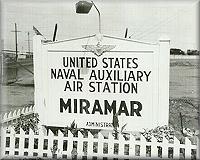
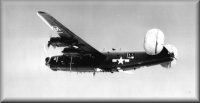
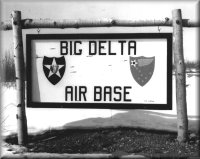

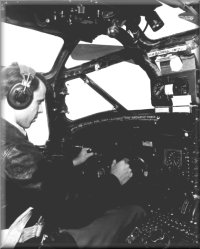
Pilot LT Arthur G. Elder (LCDR Retired)
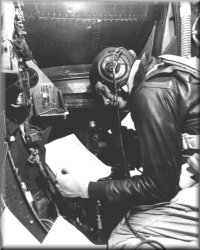
Flight Line Navigator (Unidentified)
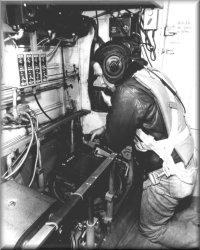
Photographer AF1 Cornelius J. "Red" Haggarty (LCDR Retired)
PB4Y-1P aircraft where taken on 15 July, 1948, on the same flight as the photo discussed above. These were taken on a flight over the Alaska Range, between Fairbanks and Anchorage, Alaska
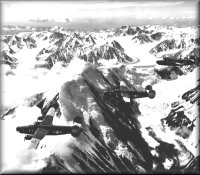
SD1, SD4, and SD3 over the Alaska Range
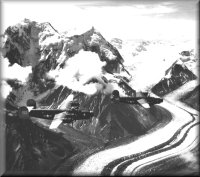
SD4 and SD1 over a glacier in the Alaska Range
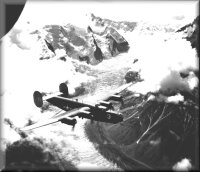
SD3 over a glacier in the Alaska Range
In addition to surveying the Naval Petrolium Reserve FOUR, VPP-1 was ordered to assign a detachment of aerial survey personnel for temporary additional duty with Medium Patrol Squadron FOUR (VP-ML-4) to assist this squadron to accomplish the aerial surveying of Tongass National Forest in southeastern Alaska. This detachment consisting of 8 officers and 18 men trained and experienced in aerial photographic reconnaissance and aerial surveying, was detached from VPP-1 at the end of March 1948 and reported to VP-ML-4 (later VP-4) at NAS Whidbey Island, Washington for further deployment to Annette Island, Alaska.
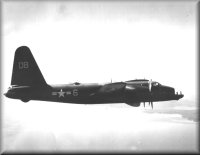
P2V-2 of VP-ML-4 (VP-4) configured for photographic mapping, showing clear nose for flight line navigator station.
 A BIT OF HISTORY: "... A BIT OF HISTORY: "... Title: "Patrol Squadron Four Aerial Survey of Southeastern Alaska 1948 Cruise Book"..." CruiseBook mentions FASRON-112, VP-61, and VP-4. [10JAN2000] Title: "Patrol Squadron Four Aerial Survey of Southeastern Alaska 1948 Cruise Book"..." CruiseBook mentions FASRON-112, VP-61, and VP-4. [10JAN2000]
Circa 1947
 A BIT OF HISTORY: "...Following the end of the war, six Navy squadrons continued to fly the Privateer. VP-61, based at NAS North Island, San Diego, California, did extensive photo mapping of Alaska between 1947 and 1949." http://www.csd.uwo.ca:80/~pettypi/elevon/baugher_us/b024-37.html A BIT OF HISTORY: "...Following the end of the war, six Navy squadrons continued to fly the Privateer. VP-61, based at NAS North Island, San Diego, California, did extensive photo mapping of Alaska between 1947 and 1949." http://www.csd.uwo.ca:80/~pettypi/elevon/baugher_us/b024-37.html
Circa 1945
 A BIT OF HISTORY: "...I recently obtained a scrapbook owned by LT(jg) John Bertolet "Jack" Philson relating to VPB-61 - Circa 1945. John Bertolet "Jack" Philson (1921-2001) entered the U.S. Navy in 1943 and was a pilot and navigator flying the PBY Catalina during World War II..." Contributed by Jerzy Kolakowski jerzykolakowski01@gmail.com [06JUN2017] A BIT OF HISTORY: "...I recently obtained a scrapbook owned by LT(jg) John Bertolet "Jack" Philson relating to VPB-61 - Circa 1945. John Bertolet "Jack" Philson (1921-2001) entered the U.S. Navy in 1943 and was a pilot and navigator flying the PBY Catalina during World War II..." Contributed by Jerzy Kolakowski jerzykolakowski01@gmail.com [06JUN2017]
VPB-61 Log Book (including other assignment)
Assortment of Official Documentation (i.e., flight training, etc.)
 A BIT OF HISTORY: "...FAW-6, VPB-61 - War Diary September 1945..." Official U. S. Navy Records (National Archives and Records Administration) via Fold3 http://www.fold3.com/ [21NOV2012] A BIT OF HISTORY: "...FAW-6, VPB-61 - War Diary September 1945..." Official U. S. Navy Records (National Archives and Records Administration) via Fold3 http://www.fold3.com/ [21NOV2012]
 A BIT OF HISTORY: "...FAW-6, VPB-61 - War Diary August 1945..." Official U. S. Navy Records (National Archives and Records Administration) via Fold3 http://www.fold3.com/ [21NOV2012] A BIT OF HISTORY: "...FAW-6, VPB-61 - War Diary August 1945..." Official U. S. Navy Records (National Archives and Records Administration) via Fold3 http://www.fold3.com/ [21NOV2012]
 A BIT OF HISTORY: "...FAW-6, VPB-61 - War Diary July 1945..." Official U. S. Navy Records (National Archives and Records Administration) via Fold3 http://www.fold3.com/ [21NOV2012] A BIT OF HISTORY: "...FAW-6, VPB-61 - War Diary July 1945..." Official U. S. Navy Records (National Archives and Records Administration) via Fold3 http://www.fold3.com/ [21NOV2012]
 A BIT OF HISTORY: "...FAW-6, VPB-61 - War Diary June 1945..." Official U. S. Navy Records (National Archives and Records Administration) via Fold3 http://www.fold3.com/ [21NOV2012] A BIT OF HISTORY: "...FAW-6, VPB-61 - War Diary June 1945..." Official U. S. Navy Records (National Archives and Records Administration) via Fold3 http://www.fold3.com/ [21NOV2012]
 A BIT OF HISTORY: "...FAW-6, VPB-61 - War Diary May 1945..." Official U. S. Navy Records (National Archives and Records Administration) via Fold3 http://www.fold3.com/ [21NOV2012] A BIT OF HISTORY: "...FAW-6, VPB-61 - War Diary May 1945..." Official U. S. Navy Records (National Archives and Records Administration) via Fold3 http://www.fold3.com/ [21NOV2012]
 A BIT OF HISTORY: "...FAW-6, VPB-61 - War Diary April 1945..." Official U. S. Navy Records (National Archives and Records Administration) via Fold3 http://www.fold3.com/ [21NOV2012] A BIT OF HISTORY: "...FAW-6, VPB-61 - War Diary April 1945..." Official U. S. Navy Records (National Archives and Records Administration) via Fold3 http://www.fold3.com/ [21NOV2012]
 A BIT OF HISTORY: "...FAW-6, VPB-61 - War Diary March 1945..." Official U. S. Navy Records (National Archives and Records Administration) via Fold3 http://www.fold3.com/ [21NOV2012] A BIT OF HISTORY: "...FAW-6, VPB-61 - War Diary March 1945..." Official U. S. Navy Records (National Archives and Records Administration) via Fold3 http://www.fold3.com/ [21NOV2012]
 A BIT OF HISTORY: "...FAW-6, VPB-61 - War Diary February 1945..." Official U. S. Navy Records (National Archives and Records Administration) via Fold3 http://www.fold3.com/ [21NOV2012] A BIT OF HISTORY: "...FAW-6, VPB-61 - War Diary February 1945..." Official U. S. Navy Records (National Archives and Records Administration) via Fold3 http://www.fold3.com/ [21NOV2012]
 A BIT OF HISTORY: "...FAW-6, VPB-61 - War Diary October 1944..." Official U. S. Navy Records (National Archives and Records Administration) via Fold3 http://www.fold3.com/ [21NOV2012] A BIT OF HISTORY: "...FAW-6, VPB-61 - War Diary October 1944..." Official U. S. Navy Records (National Archives and Records Administration) via Fold3 http://www.fold3.com/ [21NOV2012]
 A BIT OF HISTORY: "...PBY BUNO: 63993 USN History Card..." WebSite: Yahoo PBY Group http://groups.yahoo.com/group/PBY/ [11FEB2007] A BIT OF HISTORY: "...PBY BUNO: 63993 USN History Card..." WebSite: Yahoo PBY Group http://groups.yahoo.com/group/PBY/ [11FEB2007]- Accepted 19JAN44
- Delivered 20JAN44
- OTU FAW-14
- Hedron FAW-6 31AUG44-DEC44
- VPB-91 DEC44-MAR45
- VPB-61 MAR45-SEP45
- Hedron FAW-6 Sep45-DEC45
- Pool Hedron FAW-4 DEC45-APR46
- NAF Philadelphia APR46-JAN47
- NART NAS Olathe, Kansas JAN47-AUG48
- Pool Philadelphia, Mustin Field 31AUG48
- O&R Philadelphia JAN50
- Retired JAN50
- SOC O&R Philadelphia JUN50
- Total hours flown 2215
Circa 1944
 A BIT OF HISTORY: "...Patrol Squadron SIXTY-ONE (VP-61) - U. S. Action with Enemy on 14MAY44..." Official U. S. Navy Documention [27JAN2013] A BIT OF HISTORY: "...Patrol Squadron SIXTY-ONE (VP-61) - U. S. Action with Enemy on 14MAY44..." Official U. S. Navy Documention [27JAN2013]
 A BIT OF HISTORY: "...Patrol Squadron SIXTY-ONE (VP-61) - U. S. Action with Enemy on 06MAY44..." Official U. S. Navy Documention [27JAN2013] A BIT OF HISTORY: "...Patrol Squadron SIXTY-ONE (VP-61) - U. S. Action with Enemy on 06MAY44..." Official U. S. Navy Documention [27JAN2013]
 A BIT OF HISTORY: "...History of FAW-6 - 02NOV43-31DEC44. History Submitted: January 24, 1945. Squadron's Assigned: VP-12, VP-41, VP-42, VP-43, VP-45, VP-53, VP-61, VPB-62, VPB-91, VPB-120, VPB-131, VP-135, VP-136, VP-138, VP-139, VP-142, VPB-144, VP-146, VP-151, VPB-199..." Official U. S. Navy Records (National Archives and Records Administration) via Fold3 http://www.fold3.com/ [28NOV2012] A BIT OF HISTORY: "...History of FAW-6 - 02NOV43-31DEC44. History Submitted: January 24, 1945. Squadron's Assigned: VP-12, VP-41, VP-42, VP-43, VP-45, VP-53, VP-61, VPB-62, VPB-91, VPB-120, VPB-131, VP-135, VP-136, VP-138, VP-139, VP-142, VPB-144, VP-146, VP-151, VPB-199..." Official U. S. Navy Records (National Archives and Records Administration) via Fold3 http://www.fold3.com/ [28NOV2012]
 A BIT OF HISTORY: A BIT OF HISTORY:   VP-61 History "...Photograph's from my Father's (AMM1 Arthur "AJ" HELMA) personal collection. October 30, 1944 (Birthday Party), LT Coe's Crew before leaving for the States in November 1944 and two other photograph's dated September 15th and October 30th, 1944.." Contributed by Don djhelma@comcast.net [28SEP2010] VP-61 History "...Photograph's from my Father's (AMM1 Arthur "AJ" HELMA) personal collection. October 30, 1944 (Birthday Party), LT Coe's Crew before leaving for the States in November 1944 and two other photograph's dated September 15th and October 30th, 1944.." Contributed by Don djhelma@comcast.net [28SEP2010]
 A BIT OF HISTORY: A BIT OF HISTORY:   VP-61 History "...Photograph's from my Father's (AMM1 Arthur "AJ" HELMA) personal collection. Various Volcanic, etc. pictures (with descriptions) taken November 1944.." Contributed by Don djhelma@comcast.net [28SEP2010] VP-61 History "...Photograph's from my Father's (AMM1 Arthur "AJ" HELMA) personal collection. Various Volcanic, etc. pictures (with descriptions) taken November 1944.." Contributed by Don djhelma@comcast.net [28SEP2010]
 A BIT OF HISTORY: A BIT OF HISTORY:   VP-61 History "...Photograph's from my Father's (AMM1 Arthur "AJ" HELMA) personal collection. Various crew pictures (with descriptions) taken May 1944.." Contributed by Don djhelma@comcast.net [28SEP2010] VP-61 History "...Photograph's from my Father's (AMM1 Arthur "AJ" HELMA) personal collection. Various crew pictures (with descriptions) taken May 1944.." Contributed by Don djhelma@comcast.net [28SEP2010]
 A BIT OF HISTORY: A BIT OF HISTORY:   VP-61 History "...Photograph's from my Father's (AMM1 Arthur "AJ" HELMA) personal collection. Squadron Photograph of Enlisted Personnel - Circa 1944 or 1945 (when the squadron was disestablished).." Contributed by Don djhelma@comcast.net [28SEP2010] VP-61 History "...Photograph's from my Father's (AMM1 Arthur "AJ" HELMA) personal collection. Squadron Photograph of Enlisted Personnel - Circa 1944 or 1945 (when the squadron was disestablished).." Contributed by Don djhelma@comcast.net [28SEP2010]
 A BIT OF HISTORY: A BIT OF HISTORY:   VP-61 History "...Photograph's from my Father's (AMM1 Arthur "AJ" HELMA) personal collection. Honory ORder of the 180th Meridian ATTU - April 22nd, 1944.." Contributed by Don djhelma@comcast.net [28SEP2010] VP-61 History "...Photograph's from my Father's (AMM1 Arthur "AJ" HELMA) personal collection. Honory ORder of the 180th Meridian ATTU - April 22nd, 1944.." Contributed by Don djhelma@comcast.net [28SEP2010]
 A BIT OF HISTORY: "...Location of U. S. Naval Aircraft - Dated 11 Jan 1944..." WebSite: Naval Historical Center http://www.history.navy.mil/ [29SEP2006] A BIT OF HISTORY: "...Location of U. S. Naval Aircraft - Dated 11 Jan 1944..." WebSite: Naval Historical Center http://www.history.navy.mil/ [29SEP2006]
VP SQUADRONS MENTIONED
VD-1, VD-2, VD-3 and VD-4
VJ-1, VJ-2, VJ-3, VJ-4, VJ-5, VJ-7, VJ-8, VJ-9, VJ-10, VJ-11, VJ-12, VJ-13, VJ-14, VJ-15, and VJ-16
VP-6 Coast Guard
VP-11, VP-12, VP-13, VP-14, VP-15, VP-16, VP-17, VP-18 and VP-19
VP-20, VP-23 and VP-24
VP-32, VP-33 and VP-34
VP-43, VP-44 and VP-45
VP-52 and VP-54
VP-61 and VP-62
VP-71, VP-72, VP-73 and VP-74
VP-81 and VP-84
VP-91, VP-92 and VP-94
VP-101, VP-102, VP-103, VP-104, VP-105, VP-106, VP-107, VP-108 and VP-109
VP-110, VP-111, VP-112, VP-113, VP-115, VP-116 and VP-117
VP-126, VP-127, VP-128 and VP-129
VP-130, VP-131, VP-132, VP-133, VP-134, VP-135, VP-136, VP-137, VP-138 and VP-139
VP-140, VP-141, VP-142, VP-143, VP-144, VP-145, VP-146, VP-147, VP-148 and VP-149
VP-150 and VP-151
VP-201, VP-203, VP-204, VP-205, VP-208 and VP-209
VP-210, VP-211, VP-212, VP-213, VP-214, VP-215 and VP-216
 HISTORY: "23OCT44--LT R. L. Ashcraft in PBY-5A Bu. No. 48439 rescued Army P-40 pilot from water off Kanaga Island, Alaska. P-40 crashed from undetermined causes...plus "photo copies" and more!" Contributed by Eric Mitchell eric_mitchell@ccmail.com WEBSITE: http://www.pby.com HISTORY: "23OCT44--LT R. L. Ashcraft in PBY-5A Bu. No. 48439 rescued Army P-40 pilot from water off Kanaga Island, Alaska. P-40 crashed from undetermined causes...plus "photo copies" and more!" Contributed by Eric Mitchell eric_mitchell@ccmail.com WEBSITE: http://www.pby.com
Circa 1943 - 1944
 A BIT OF HISTORY: "...Photograph's from my Father's (AMM1 Arthur "AJ" HELMA) personal collection. This is Dad's Flight Logbook from April 1943 through December 1944..." Contributed by Don djhelma@comcast.net [28SEP2010] A BIT OF HISTORY: "...Photograph's from my Father's (AMM1 Arthur "AJ" HELMA) personal collection. This is Dad's Flight Logbook from April 1943 through December 1944..." Contributed by Don djhelma@comcast.net [28SEP2010]
 "...On September 29th, 1944 Crew-8 "found ditched B-24" and returned to NAS Adak, Alaska..." Contributed by Don djhelma@comcast.net [29SEP2010] "...On September 29th, 1944 Crew-8 "found ditched B-24" and returned to NAS Adak, Alaska..." Contributed by Don djhelma@comcast.net [29SEP2010]
Circa 1943
 A BIT OF HISTORY: "...Location of U. S. Naval Aircraft - Dated 31 May 1943..." WebSite: Naval Historical Center http://www.history.navy.mil/ [02OCT2006] A BIT OF HISTORY: "...Location of U. S. Naval Aircraft - Dated 31 May 1943..." WebSite: Naval Historical Center http://www.history.navy.mil/ [02OCT2006]
VP SQUADRONS MENTIONED
CASU
PATSU
VD-1, VD-2 and VD-3
VJ-1, VJ-2, VJ-3, VJ-4, VJ-5, VJ-7 and VJ-10
VP-1
VP-11, VP-12, VP-13, VP-14 and VP-15
VP-23
VP-32, VP-33 and VP-34
VP-43, VP-44 and VP-45
VP-52, VP-53 and VP-54
VP-61, VP-62 and VP-63
VP-71, VP-72, VP-73 and VP-74
VP-81 and VP-84
VP-91, VP-92 and VP-94
VP-101, VP-102, VP-103, VP-104, VP-105, VP-106, VP-107, VP-108 and VP-109
VP-125, VP-126, VP-127 and VP-128
VP-130, VP-131, VP-132, VP-133, VP-134, VP-135, VP-136, VP-137, VP-138 and VP-139
VP-140, VP-142, VP-144 and VP-146
VP-201, VP-202, VP-203, VP-204, VP-205, VP-206, VP-207, VP-208 and VP-209
VP-210, VP-211 and VP-212
 A BIT OF HISTORY: "...Location of U. S. Naval Aircraft - Dated 16 Jan 1943..." WebSite: Naval Historical Center http://www.history.navy.mil/ [01OCT2006] A BIT OF HISTORY: "...Location of U. S. Naval Aircraft - Dated 16 Jan 1943..." WebSite: Naval Historical Center http://www.history.navy.mil/ [01OCT2006]
VP SQUADRONS MENTIONED
CASU and PATSU
VJ-1, VJ-2, VJ-3, VJ-4, VJ-5, VJ-6, VJ-7 and VJ-8
VP-6 Coast Guard
VP-3
VP-11 and VP-12
VP-23 and VP-24
VP-31, VP-32, VP-33 and VP-34
VP-41, VP-42, VP-43 and VP-44
VP-51, VP-52, VP-53 and VP-54
VP-61, VP-62 and VP-63
VP-71, VP-72, VP-73 and VP-74
VP-81, VP-82, VP-83 and VP-84
VP-91, VP-92VP-93, and VP-94
VP-101, VP-102, VP-103, VP-104, VP-105, VP-106, VP-107, VP-108 and VP-109
VP-110
VP-127, VP-128 and VP-129
VP-131, VP-132, VP-133 and VP-134
VP-200, VP-201, VP-202, VP-203, VP-204, VP-205, VP-206, VP-207, VP-208 and VP-209
VP-210, VP-211, VP-210, and VP-216
 A BIT OF HISTORY: "...Location of U. S. Naval Aircraft - Dated 09 Nov 1943..." WebSite: Naval Historical Center http://www.history.navy.mil/ [01OCT2006] A BIT OF HISTORY: "...Location of U. S. Naval Aircraft - Dated 09 Nov 1943..." WebSite: Naval Historical Center http://www.history.navy.mil/ [01OCT2006]
VP SQUADRONS MENTIONED
CASU and PATSU
VD-1, VD-2, VD-3 and VD-4
VJ-1, VJ-2, VJ-3, VJ-4, VJ-5, VJ-15, and VJ-16
VP-6 Coast Guard
VP-1
VP-11, VP-12, VP-13, VP-14, VP-15 and VP-16
VP-23 and VP-24
VP-32, VP-33 and VP-34
VP-43, VP-44 and VP-45
VP-52, VP-53 and VP-54
VP-61, VP-62 and VP-63
VP-71, VP-72, VP-73 and VP-74
VP-81 and VP-84
VP-91, VP-92 and VP-94
VP-101, VP-102, VP-103, VP-104, VP-105, VP-106, VP-107, VP-108 and VP-109
VP-110, VP-111, VP-112, VP-113, VP-114, VP-115 and VP-116
VP-125, VP-126, VP-127, VP-128 and VP-129
VP-130, VP-131, VP-132, VP-133, VP-134, VP-135, VP-136, VP-137, VP-138 and VP-139
VP-140, VP-141, VP-142, VP-143, VP-144, VP-145, VP-146, VP-147, VP-148 and VP-149
VP-150
VP-201, VP-202, VP-203, VP-204, VP-205, VP-206, VP-207, VP-208 and VP-209
VP-210, VP-211, VP-212, VP-213, VP-214, VP-215 and VP-216
 A BIT OF HISTORY: "...Location of U. S. Naval Aircraft - Dated 09 Feb 1943..." WebSite: Naval Historical Center http://www.history.navy.mil/ [28SEP2006] A BIT OF HISTORY: "...Location of U. S. Naval Aircraft - Dated 09 Feb 1943..." WebSite: Naval Historical Center http://www.history.navy.mil/ [28SEP2006]
VP SQUADRONS MENTIONED
VJ-1, VJ-2, VJ-3, VJ-7 and VJ-8
VP-11, VP-12, VP-13 and VP-14
VP-23 and VP-24
VP-31, VP-32, VP-33 and VP-34
VP-41, VP-42, VP-43 and VP-44
VP-61, VP-62, and VP-63
VP-71, VP-72, VP-73 and VP-74
VP-81, VP-82, VP-83 and VP-84
VP-91, VP-92, VP-93 and VP-94
VP-101
VP-127, VP-128 and VP-129
VP-130, VP-132, VP-133 and VP-134
VP-201, VP-202, VP-203, VP-205, VP-206, VP-207, VP-208 and VP-209,
VP-210, VP-211 and VP-212
 A BIT OF HISTORY: "...WWII USN VPB-61 ARM2 W. O. Cunningham Logbook entries..." Contributed by Stephen Scriver scriver@telusplanet.net [23MAR2003] A BIT OF HISTORY: "...WWII USN VPB-61 ARM2 W. O. Cunningham Logbook entries..." Contributed by Stephen Scriver scriver@telusplanet.net [23MAR2003]
 A BIT OF HISTORY: "00JUL43--Under the expert leadership of Commodore Leslie E. Gehres, Fleet Air Wing FOUR, had participated in the big push to out the Japs from Attu in May of 1943, and the retaking of Kiska in July of 1943 and was now pressing the attack closer and closer to the Japanese positions in the Northern Kuriles with the big Naval Base on Paramishiru as the main objective. FORTY-THREE's stay in NAS Adak, Alaska was of slight duration and after reporting to Commander Fleet Air Wing FOUR, for duty, the squadrons ten planes took off for NAS Attu, Alaska were they were to be based fot the next seven months. Immediately upon FORTY-THREE's reporting for duty, VP-45, operation from the U. S. S. Casco, anchored in Casco Cove (names after the gallant ender) and VP-61, stationed at Anchitka returned to NAS Seattle, Washington, and FORTY-THREE possessed the dubious honor of being the only "P" Boat squadron in the Alasks Aleutian area..." Archive: NARA-San Bruno, Record Group: 321534009, SubGroup: TBD, Page: 07, Unit: VP-43..." Contributed by Eric Mitchell eric_mitchell@ccmail.com WEBSITE: www.pby.com A BIT OF HISTORY: "00JUL43--Under the expert leadership of Commodore Leslie E. Gehres, Fleet Air Wing FOUR, had participated in the big push to out the Japs from Attu in May of 1943, and the retaking of Kiska in July of 1943 and was now pressing the attack closer and closer to the Japanese positions in the Northern Kuriles with the big Naval Base on Paramishiru as the main objective. FORTY-THREE's stay in NAS Adak, Alaska was of slight duration and after reporting to Commander Fleet Air Wing FOUR, for duty, the squadrons ten planes took off for NAS Attu, Alaska were they were to be based fot the next seven months. Immediately upon FORTY-THREE's reporting for duty, VP-45, operation from the U. S. S. Casco, anchored in Casco Cove (names after the gallant ender) and VP-61, stationed at Anchitka returned to NAS Seattle, Washington, and FORTY-THREE possessed the dubious honor of being the only "P" Boat squadron in the Alasks Aleutian area..." Archive: NARA-San Bruno, Record Group: 321534009, SubGroup: TBD, Page: 07, Unit: VP-43..." Contributed by Eric Mitchell eric_mitchell@ccmail.com WEBSITE: www.pby.com
Circa 1942 - 1945
 A BIT OF HISTORY: Naval Historical Center, Department Of The Navy, Washington, D. C http://www.history.navy.mil/branches/dictvol2.htm [28APR2001] A BIT OF HISTORY: Naval Historical Center, Department Of The Navy, Washington, D. C http://www.history.navy.mil/branches/dictvol2.htm [28APR2001]

 VPB-61 250KB VPB-61 250KB
Circa 1942
 A BIT OF HISTORY: "...History of FAW-4 - History of Headquarters Squadron Fleet Air Wing Four - Established: 01OCT42. Squadron's Assigned: VP-41, VP-42, VP-43, VP-49, VP-56, VP-61, VP-62, VP-70, VPB-135, VPB-136 and VPB-139 - Submitted January 18, 1945..." Official U. S. Navy Records (National Archives and Records Administration) via Fold3 http://www.fold3.com/ [26NOV2012] A BIT OF HISTORY: "...History of FAW-4 - History of Headquarters Squadron Fleet Air Wing Four - Established: 01OCT42. Squadron's Assigned: VP-41, VP-42, VP-43, VP-49, VP-56, VP-61, VP-62, VP-70, VPB-135, VPB-136 and VPB-139 - Submitted January 18, 1945..." Official U. S. Navy Records (National Archives and Records Administration) via Fold3 http://www.fold3.com/ [26NOV2012]
 A BIT OF HISTORY: "...This is from my Dad's (LCDR Hjalmer A. Jordal) personal collection - June 1942 - December 1942..." Contributed by La Dona ladonam@prodigy.net [11FEB2011] A BIT OF HISTORY: "...This is from my Dad's (LCDR Hjalmer A. Jordal) personal collection - June 1942 - December 1942..." Contributed by La Dona ladonam@prodigy.net [11FEB2011]
 A BIT OF HISTORY: "...Op-40-A-KB - (SC)A6-4/VZ - January 6, 1942 - Location of U. S. Naval Aircraft..." WebSite: Naval Historical Center http://www.history.navy.mil/ [23SEP2006] A BIT OF HISTORY: "...Op-40-A-KB - (SC)A6-4/VZ - January 6, 1942 - Location of U. S. Naval Aircraft..." WebSite: Naval Historical Center http://www.history.navy.mil/ [23SEP2006]
VP SQUADRONS MENTIONED
VP-11, VP-12 and VP-14
VP-23 and VP-24
VP-31, VP-32, VP-33 and VP-34
VP-41, VP-42, VP-43 and VP-44
VP-51, VP-52, VP-53 and VP-54
VP-61, VP-62, VP-63
VP-71, VP-72, VP-73 and VP-74
VP-81 and VP-83
VP-91, VP-92 and VP-94
VP-101
VP-201, VP-202, VP-203, VP-204, VP-205, VP-206, VP-207, VP-208, VP-209, VP-210, VP-211 and VP-212
 A BIT OF HISTORY: "...My Dad, LT Lawrence Joseph Krell (Deceased), served with many squadron including NAF Detroit, Michigan (1935-1939), NAS Pensacola, Florida (1939-1942), VP-62 (1942), VP-42 (1942), FAW-6 (1943), VP-43 (1943-1944), VH-2 (1944), VX-2 (1944), VR-11 (1945) and VR-1 (1945) as reflected in one of his Flight Log Books..." Contributed by his daughter Larinda Pilkerton lpilkerton@sandi.net [30OCT2005] A BIT OF HISTORY: "...My Dad, LT Lawrence Joseph Krell (Deceased), served with many squadron including NAF Detroit, Michigan (1935-1939), NAS Pensacola, Florida (1939-1942), VP-62 (1942), VP-42 (1942), FAW-6 (1943), VP-43 (1943-1944), VH-2 (1944), VX-2 (1944), VR-11 (1945) and VR-1 (1945) as reflected in one of his Flight Log Books..." Contributed by his daughter Larinda Pilkerton lpilkerton@sandi.net [30OCT2005]
 A BIT OF HISTORY: "04APR42--History of Patrol Bombing Squadron Sixty-One...Chronology, Narrative, Action Reports, NARA San Bruno 9NS-313-94-01, Box 7 of 7, Folder 321352...plus "photo copies" and more!" Contributed by Eric Mitchell eric_mitchell@ccmail.com WEBSITE: http://www.pby.com A BIT OF HISTORY: "04APR42--History of Patrol Bombing Squadron Sixty-One...Chronology, Narrative, Action Reports, NARA San Bruno 9NS-313-94-01, Box 7 of 7, Folder 321352...plus "photo copies" and more!" Contributed by Eric Mitchell eric_mitchell@ccmail.com WEBSITE: http://www.pby.com
 A BIT OF HISTORY: "14JUN42--VP-61 transferred Bu. No. 04463 to Patrol Wing FOUR and Plane Bu. No. 04483 to Patrol Squadron FIFTY-ONE, leaving VP-61VP-61..." Contributed by Eric Mitchell eric_mitchell@ccmail.com WEBSITE: www.pby.com A BIT OF HISTORY: "14JUN42--VP-61 transferred Bu. No. 04463 to Patrol Wing FOUR and Plane Bu. No. 04483 to Patrol Squadron FIFTY-ONE, leaving VP-61VP-61..." Contributed by Eric Mitchell eric_mitchell@ccmail.com WEBSITE: www.pby.com
 A BIT OF HISTORY: "..I was a radioman in a PBY squadron at NAS Kaneohe Bay, Pearl Harbor, Hawaii when the war started and was luckey enough to be sent back to flight school in Feb. '42. Two weeks after I left, my crew flew into Makapuu Point on Ohau and burned. After flight school I went directly into VP-61 in July '42. I was an enlisted pilot and most of us went into patrol type a/c which at that time ment seaplanes. We started out at Dutch Harbor and progressed westward along the Aleutian chain. We were the first squadron to be stationed on most of those islands, sometimes not having quarters or ramps to beach our planes. The first tour was in PBY5 and the next in PBY5A. My plane and crew, under the command of Patrol Plane Commander Lt. Wehmeyer was the first to land in Massacre Bay on Attu when the invasion started. It was a touch and go but the first landing never the less. Not sure about the spelling of the PPC's name but it's been a long time..." Contributed by Cass E. Phillips cphillips@powerh.net [E-Mail Updated 03SEP98] A BIT OF HISTORY: "..I was a radioman in a PBY squadron at NAS Kaneohe Bay, Pearl Harbor, Hawaii when the war started and was luckey enough to be sent back to flight school in Feb. '42. Two weeks after I left, my crew flew into Makapuu Point on Ohau and burned. After flight school I went directly into VP-61 in July '42. I was an enlisted pilot and most of us went into patrol type a/c which at that time ment seaplanes. We started out at Dutch Harbor and progressed westward along the Aleutian chain. We were the first squadron to be stationed on most of those islands, sometimes not having quarters or ramps to beach our planes. The first tour was in PBY5 and the next in PBY5A. My plane and crew, under the command of Patrol Plane Commander Lt. Wehmeyer was the first to land in Massacre Bay on Attu when the invasion started. It was a touch and go but the first landing never the less. Not sure about the spelling of the PPC's name but it's been a long time..." Contributed by Cass E. Phillips cphillips@powerh.net [E-Mail Updated 03SEP98]
Circa 1941
 A BIT OF HISTORY: "...LOCKHEED PV VENTURA and HARPOON - by Jack McKillop..." http://www.microworks.net/pacific/aviation/pv_ventura.htm [23JUN2002] A BIT OF HISTORY: "...LOCKHEED PV VENTURA and HARPOON - by Jack McKillop..." http://www.microworks.net/pacific/aviation/pv_ventura.htm [23JUN2002]
Waiting for permission to post entire article.
 A BIT OF HISTORY: "...Albemarle - DEPARTMENT OF THE NAVY -- NAVAL HISTORICAL CENTER..." WebSite: Naval Historical Center http://www.history.navy.mil/danfs/a5/albemarle-iii.htm [09APR2005] A BIT OF HISTORY: "...Albemarle - DEPARTMENT OF THE NAVY -- NAVAL HISTORICAL CENTER..." WebSite: Naval Historical Center http://www.history.navy.mil/danfs/a5/albemarle-iii.htm [09APR2005]
Albemarle
A town and a sound in North Carolina and a county in Virginia. All three were named for General George Monck, the first Duke of Albemarle and one of the original Carolina proprietors
III
(AV-5: dp. 8,761; 1. 527'4"; b. 69'3"; dr. 21'11"; s. 19.7 k.; cpl. 1,195; a. 4 5", 8 .50-cal. mg.; cl. Curtiss
The third USS Albemarle (AV-5) was laid down on 12 June 1939 at Camden, N.J., by the New York Shipbuilding Corp.; launched on 13 July 1940; sponsored by Mrs. Beatrice C. Compton, the wife of the Honorable Lewis Compton, Assistant Secretary of the Navy; and commissioned at the Philadelphia Navy Yard on 20 December 1940, Comdr. Henry M. Mullinnix in command.
Albemarle remained at Philadelphia, fitting out, through mid-January, 1941. Underway for Newport, R.I., on the morning of 28 January, the seaplane tender arrived at her destination on the 30th, and loaded torpedoes. She sailed the following day for Norfolk, arriving on 1 February, and over the ensuing days remained in that area, loading bombs and pyrotechnics and calibrating her degaussing gear, before she sailed on her shakedown cruise on the afternoon of 6 February, setting course for Guantanamo Bay, Cuba.
The seaplane tender shifted thence to Havana on the morning of 18 February, and over the days which followed her captain made the usual formal calls dictated by diplomatic protocol. In Havana harbor, Albemarle dressed ship for Washington's Birthday, her 21-gun salute to the American national holiday returned gun-for-gun by the Cuban gunboat Yarn. On the morning of 24 February, the ship got underway for the Canal Zone.
Diverted while en route, Albemarle anchored in the harbor at San Juan, Puerto Rico, on the morning of 28 February, and that afternoon received the official call of Rear Admiral Raymond A. Spruance, Commandant of the 10th Naval District. That same day, she embarked 91 men from VP-51 and VP-61 from VP-52 for temporary duty and transportation, and sailed for Norfolk, Virginia on the morning of 2 March. While en route, Comdr. Mullinnix was relieved as commanding officer by Comdr. H. B. Sallada.
Albemarle moored at Pier 7, Naval Operating Base (NOB) Norfolk, Virginia, on the afternoon of 5 March, but lingered there for less than a day, getting underway the following afternoon for Philadelphia. She returned to the Philadelphia Navy Yard and spent the rest of March there, undergoing post-shakedown repairs.
The seaplane tender departed Philadelphia on 6 April, and arrived back at Norfolk, Virginia the following afternoon; there she took on board depth charges and depth bombs. She sailed for Newport on the morning of 10 April, and soon after standing out into international waters past the Virginia capes, met her escort for the trip—six "flush-deck" destroyers, one of which was the ill-fated Reuben James (DD-245). That afternoon she fueled two of her escorts, Sturtevant (DD-240) and MacLeish (DD-220) at the same time, the former to starboard, the latter to port.
Albemarle then anchored in the harbor of refuge, off Block Island, late on the afternoon of 11 April and, accompanied by the destroyer Truxtun (DD-229), calibrated her radio direction finders. She then set out to finish her voyage up the eastern seaboard to Newport, arriving at her destination late on the afternoon of 13 April. She there joined a host of warships, ranging from the battleship Texan (BB-35) and the heavy cruisers Tuncaloosa (CA-37) and Wichita (CA^IS) to old and new-type destroyers and the destroyer tender Prairie (AD-15).
While Albemarle had been on her shakedown, the United States determination to aid the British in the Battle of the Atlantic had resulted in the establishment, on 1 March, of the Support Force, commanded by Rear Admiral Arthur LeRoy Bristol, to protect the vital lifeline between the United States and Great Britain in the North Atlantic. It was formed around destroyers and patrol plane squadrons; the latter would be tended by small seaplane tenders (ex-destroyers and ex-minesweepers) and Albemarle.
Over the next few days, the seaplane tender operated in local waters, at Narragansett Bay, off Martha's Vineyard and Quonset Point, Rhode Island, running drills of various kinds and conducting target practices. Rear Admiral Bristol came on board briefly on 28 April and wore his flag in Albemarle; that same day, she embarked her former commanding officer, now Capt. Mullinnix, who was now Commander, Patrol Wing, Support Force; men of VP-56 reported on board in connection with advanced base operations, as did men from VP-55. The following day, the planes from those two squadrons commenced night-flying operations.
Albemarle, after again wearing Rear Admiral Bristol's flag on 2 May, departed Newport for Norfolk, Virginia on 4 May, arriving the following day. The seaplane tender then cleared the Virginia capes on the morning of 9 May for Newport, and arrived there the following morning. She embarked officers and men of VP-52 on 12 May and then sailed the following morning (13 May) for Argentia, Newfoundland, Canada. Ultimately anchoring in Little Placentia Bay, Argentia, Newfoundland, Canada, on the morning of 18 May, Albemarle was soon laying 13 seaplane moorings and gathering data on the weather of the region, establishing the advanced base for VP-52's operations from Argentia, Newfoundland, Canada.
Over the days that followed, in addition to tending the planes assigned to her, she also fueled a succession of destroyers. On 20 May, she received a visit from not only Rear Admiral Bristol— his first visit to Argentia, Newfoundland, Canada, which he later made his headmarters— but Rear Admiral John H. Towers, the Chief of the Bureau of Aeronautics, who both arrived separately in planes from VP-56. Both flag officers departed the following morning.
Twelve PBYs of VP-52 arrived at Argentia, Newfoundland, Canada from Quonset Point, Rhode Island on 18 May, and immediately commenced familiarization flights in the region—activities which were suddenly cancelled on 24 May. On that day, the German battleship Bismarck, which had left Norwegian waters shortly before in company with the heavy cruiser Prinz Eiu/en on what was to be a raiding cruise into the Atlantic, encountered and destroyed the British battle cruiser HMS Hood. An anxious Prime Minister Winston Churchill, concerned over the convoy routes that lay open to the powerful German battleship, immediately cabled President Roosevelt and requested American help.
Albemarle quickly refueled the aircraft that had been flying training missions that morning and readied others for the urgent mission. At 1440 the first group of four PBYs lifted off, followed a little less than three hours later, at 1720, by a second flight of seven. The pilots of the "Catalinas" were briefed for a long reconnaissance mission that would take them some 500 miles southeast of Cape Farewell, Greenland. They encountered foul weather and very dangerous flying conditions in the course of their extensive searches, did not find their quarry in the murk, and were compelled by the fog and darkness to seek haven at various bays in Newfoundland, Labrador, Quebec, and adjoining islands.
Albemarle remained at Argentia, Newfoundland, Canada until 12 June, when she sailed for Norfolk, Virginia, arriving on the 15th. There she loaded supplies, stores, ammunition and gasoline, before getting underway to return to Newfoundland on 20 June. Escorted there by the destroyer MacLeish, Albemarle touched at Halifax en route (22 June), and then proceeded on to Argentia, Newfoundland, Canada, screened by MacLeish and Cole (DD-155), arriving on 24 June. The seaplane tender supported the operations of VP-71, VP-72 and VP-73 until she sailed again for Norfolk, Virginia on 19 July, in company with Dallas (DD-199). Mooring at Pier 7, NOB Norfolk, Virginia on the morning of the 25th, she shifted to the Norfolk, Virginia Navy Yard later that same day and remained there, undergoing an availability, until 12 August.
Underway on the day, Albemarle, screened by the destroyer Broome(DD-210), sailed for Angentia once more, and reach her destination on the 16th, resuming her support of VP-73. She provided support for seaplane and flying boat operations out of Argentia, Newfoundland, Canada through October, 1941. Clearing Little Placentia Harbor on 1 November, Albemarle sailed for Casco Bay, Maine, arriving there on the 3d; she then pushed on for Norfolk, Virginia, arriving there on the 7th.
On the day that Japanese planes attacked the Pacific Fleet at Pearl Harbor, Hawaii, 7 December 1941, Albemarle lay at NOB Norfolk, Virginia, embarking passengers before she was scheduled to get underway for anchorage at Lynnhaven Roads. On Christmas Day, 1941, the seaplane tender got underway for Newport and Argentia, Newfoundland, Canada.
Ultimately, the ship proceeded to Reykjavik, Iceland, where she would encounter the most severe weather she would see in her career. One particular day, 15 January 1942, was memorable. She set her special sea, anchor and steaming watches and put out both anchors with 120 fathoms of chain on the starboard and 60 to port, with her main engines turning over and steam up on all boilers. The winds were clocked at 71 knots, with occasional gusts of 95, forcing the tender to drag anchor.
The gale lasted until 19 January, and caused heavy damage among the ship's patrol planes. The ship nearly collided with Wichita on one occasion, and was in danger of fouling several other ships during that time. Her starboard anchor was fouled once, and she lost the port anchor. She ultimately left Reykjavik on 19 January, steaming initially at greatly reduced speed because of the tempest, shaping course for Argentia, Newfoundland, Canada, where she would embark passengers for transportation to Norfolk, Virginia.
Reaching Norfolk, Virginia on 29 January, Albemarle then proceeded to Narraganasett Bay, and there provided tender services to VP-73 as that squadron worked with torpedoes there. On 5 March, Admiral Royal E. Ingersoll, Commander in Chief, Atlantic Fleet, made an unofficial call and inspected the ship informally. Albemarle completed her work with VP-73 and remained at anchor in Narragansett Bay until 3 April, when she proceeded to the Boston Navy Yard South Annex for an availability. Her overhaul lasted until 1 May 1942.
Upon completion of her refit, Albemarle got underway for Newport, on 5 May, and there, over the next few days, degaussed, calibrated her direction finders, and loaded aircraft for transportation to Bermuda. Underway on 15 May with Mayo (DD-422) and Benson (DD-421) as escorts, the seaplane tender reached her destination on the 17th, unloaded the planes she had brought, and immediately set sail for Narragansett Bay.
Relieving USS Pocomoke (AV-9) in connection with aircraft torpedo and submarine familiarization training, on the 19th, Albemarle remained anchored in Narragansett Bay until 12 August, providing torpedo services for a succession of squadrons: VP-94, VP-34, VP-33 and Torpedo Squadron 4. Underway on 12 August and escorted by the destroyers Livermore (DD-430), Kearny (DD-432) and Rowan (DD-405), the submarine tender sailed for Norfolk, Virginia. After her arrival there, Albemarle conducted gunnery exercises in the Chesapeake Bay operating area.
Shortly thereafter, escorted by Fletcher (DD-445) and O'Bannon (DD-450), Albemarle sailed for the Canal Zone on 5 September 1942. Damaging her starboard screw at Coco Solo, Panama, Canal Zone, the seaplane tender was ordered drydocked for repairs; after transiting the Panama Canal for the first time on 15 September, she entered dry dock at Balboa on the following day. Upon completion of repairs, she transported Army troops and marines to Rio Hato, Panama, for two days of joint Army-Navy maneuvers.
Over the next several months, Albemarle acted as fast transport of aeronautical material and men to naval air bases in the Caribbean and the Pacific coast of South America, as well as in the northern South Atlantic. During this time (September-November 1942), she visited Salinas, Ecuador; the air base at Seymour Island, in the Galapagos Islands; San Juan and Bermuda, primarily operating out of Colon and Balboa and escorted by the seaplane tender Goldsboroygh (AVD-5).
Relieved on station by the seaplane tender USS Pocomoke (AV-9), Albemarle sailed from the Canal Zone on 13 November 1942, escorted by Goldsborough and the small seaplane tender Matagorda (AVP-22). Proceeding via San Juan, Trinidad and Bermuda, the seaplane tender reached Hampton Roads on 30 November having completed her longest sustained tour of duty outside the continental limits of the United States.
Over the next seven months, Albemarle shuttled between Norfolk, Virginia and Guantanamo Bay, Cuba, Trinidad, British West Indies, San Juan, and Bermuda, on eight round-trip voyages. She varied this routine only slightly on the sixth and eighth of these, visiting Recife, Brazil for the first time (17 to 21 April 1943) on the sixth cruise and putting into the Canal Zone on the eighth. Her cargo included aviation gasoline and ammunition. Upon completion of that cycle of operations, she underwent repairs and alterations at the Boston Navy Yard between 15 June and 23 July 1943, departing on the latter date for Norfolk, Virginia, whence she resumed her cargo-carrying and transport run to Trinidad, Recife, San Juan and Guantanamo Bay. On this voyage, her last on this run, she brought back 27 German prisoners of war, survivors of a sunken U-boat.
Underway from Norfolk, Virginia on 16 September 1943, Albemarle sailed for the British Isles, escorted by the destroyers Bulmer (DD-222) and Barker (DD-213). Proceeding via Argentia, Newfoundland, Canada, the seaplane tender reached Swansea, Wales, with aeronautical cargo and passengers on 28 September, the men and freight she carried to support the newly inaugurated antisubmarine operations by patrol squadrons operating from the British Isles. Underway from Swansea on 4 October, she scraped a screw while leaving the harbor, and, after sailing via Argentia, Newfoundland, Canada, reached Boston on 15 October. She was drydocked the following day, and the damaged propeller was repaired. Albemarle returned thence to Norfolk, Virginia via the Cape Cod Canal, arriving at Norfolk, Virginia on 18 October.
Underway on 22 October as part of a task group formed around the escort carrier Croatan (CVE-25) and three destroyers, Albemarle sailed for Casablanca. Routed via Bermuda, the group reached its destination on 3 November. After discharging her cargo and disembarking her passengers, the seaplane tender then sailed for the United States on 10 November with another convoy, this one larger and formed around Croatan and the light cruiser Philadelphia (CL-41), escorted by seven destroyers, and containing Matagorda and three transports.
Albemarle made a second cruise to Casablanca before the year 1943 was out, underway on 28 November and escorted by the destroyers Barry (DD-248) and Goff (DD-247), and arriving on 7 December. She sailed on the 13th for Reykjavik, and reached that Icelandic port on the 19th. There she embarked men from VB-128 for transportation back to the United States, and proceeded out of Reykjavik on 22 December for Norfolk, Virginia. Battling heavy seas on the return voyage (making only five knots on Christmas Day), Albemarle returned to NOB, Norfolk, Virginia, on the last day of the year 1943.
Proceeding thence to Bayonne, N.J., on 4 January 1944, for upkeep and availability, Albemarle returned to Norfolk, Virginia on 17 January, and prepared for a voyage to San Juan. While outward-bound, however, on 18 January 1944, the seaplane tender fouled a buoy in a thick fog and put about for repairs. Drydocked on 20 January, Albemarle sailed again for her original destination, San Juan, the following day.
Subsequently touching at Trinidad, British West Indies and Recife, Brazil, and retracing her path calling at Trinidad, British West Indies and San Juan on the return leg of the passage, Albemarle returned to Norfolk, Virginia on 23 February for availability. She then steamed to Casablanca in company with the amphibious command ship Catoctin (AGC-5) and two destroyers, and, among her passengers on the westward bound trip, were 20 German U-boat sailors, prisoners of war. She arrived back at Norfolk, Virginia on 1 April 1944.
After upkeep at NOB, Norfolk, Virginia, Albemarle proceeded up to the Naval Supply Depot at Bayonne, where she loaded aviation cargo, between 7 and 13 April. She then sailed, via Norfolk, Virginia, to Guantanamo Bay, Trinidad, the Brazilian ports of Recife and Bahia, and San Juan, ultimately making arrival back at Norfolk, Virginia on 27 May for voyage repairs and upkeep. Loading cargo at the end of that period, including 29 dive bombers, Albemarle again shaped a course for North African waters, the seaplane tender making arrival at Casablanca on 20 June. She proceeded thence to Avonmouth, England, where she loaded cargo and embarked passengers for return to the United States. Underway for Boston on 6 July, she reached her destination on the 13th.
Albemarle spent the next month undergoing a 30-day availability for repairs and alterations at the Boston Navy Yard. Emerging from the yard on 15 August, the seaplane tender proceeded to Bayonne, to load cargo. Sailing via Norfolk, Virginia, the ship visited the familiar bases at San Juan, Trinidad, British West Indies, Recife, Brazil and Guantanamo Bay, Cuba before returning to NOB, Norfolk, Virginia, on 29 September.
After loading cargo at Bayonne (12 to 17 October), Albemarle headed south for the supply run to San Juan, Trinidad and Recife. Outward-bound the voyage proved uneventful; however, while loading ammunition and cargo at San Juan for the return leg of the voyage, an electrical fire damaged the ship's main distribution board, putting Albemarle's lighting and ventilation systems out of commission. Underway for Hampton Roads on 22 November, the seaplane tender reached Hampton Roads on the 25th, and moored at NOB, Norfolk, Virginia, on the 26th to commence an availability.
Underway for Guantanamo Bay on the last day of 1944, Albemarle dropped anchor there on 4 January 1945. Reporting to Commander, FAW-11, for temporary duty, she tended VPB-201 and VPB-210 at "Gitmo" until 17 January, when the seaplane tender sailed for Coco Solo, Panama, Canal Zone, arriving at her destination on the 19th. Thence she sailed for Trinidad, British West Indies where she tended VPB-213 from 1 to 11 February.
Shifting back to the Canal Zone soon thereafter, Atbemarle commenced tending operations for VPB-214 at Almirante Bay, Panama, on 18 February, and remained engaged in that duty until Washington's Birthday. On 25 February, the ship was designated as flagship for Commander, Air Force, Atlantic Fleet, the day after she cleared Limon Bay for the Galapagos group.
There, Albemarle tended VPB-74 and VPB-209 from 27 February to 6 March, when the seaplane tender got underway to return to the Canal Zone. She steamed thence to Guantanamo Bay and Norfolk, Virginia, arriving at the latter place on 17 March for an availability that lasted through mid-May 1945.
Albemarle cleared Norfolk, Virginia on 18 May for New York, laden with cargo, escorted by the destroyers Bernadou (DD-153) and Dallas. Two days later, the seaplane tender sailed for the British Isles in CU-71, a convoy formed around the venerable USAT George Washington. Albemarle's mission was to bring back to the United States those patrol squadrons whose task in the Atlantic had been completed with the end of the war in Europe, and whose presence was required in the still-active Pacific theater. Ultimately, Albemarle reached her destination, Avonmouth, on 30 May, and brought her passengers—men of FAW-7 — back to Norfolk, Virginia on 14 June.
Albemarle made a second voyage to Avonmouth, sailing from Hampton Roads on Independence Day 1945 and reaching her destination on 13 July. There she embarked 772 sailors and soldiers, the majority of the latter repatriated prisoners of war. Underway on the 17th, the seaplane tender arrived back at Norfolk, Virginia on the 26th.
Entering the Norfolk, Virginia Navy Yard on 28 July for repairs and alterations to fit her out for duty in the Pacific, Albemarle was in the midst of this availability when the war in the Pacific ended in mid-August, 1945. The Japanese capitulation suspended the work; and, soon thereafter, the orders to the Pacific to tend seaplanes were cancelled.
Shortly thereafter, however, Albemarle underwent alterations of a different kind, to fit her out for different duty. With repairs carried out to the ventilation and berthing arrangements, the seaplane tender departed Norfolk, Virginia on 25 September with 2,000 Navy replacements embarked, bound for the Canal Zone. She soon reported for duty as a transport under the Naval Transport Service.
Albemarle cleared Coco Solo, Panama, Canal Zone, for Pearl Harbor, Hawaii, but while transiting the Panama Canal suffered damage to her port screw. Reduced to proceeding with a single propeller, the seaplane tender put into San Francisco for repairs. Assigned to the "Magic Carpet" fleet—the ships given the job of returning American veterans home for rotation or discharge—upon completion of her repairs, Albemarle sailed westward, arriving at Pearl Harbor, Hawaii on 1 November before pushing on for New Caledonia, arriving there on 13 November, eventually arriving at NAS Alameda, California, on 28 November.
Following a second round-trip voyage to Samar, in the Philippines, and back, Albemarle underwent a three-month overhaul at the Naval Shipyard, Terminal Island, Calif., in preparation for her participation in Operation "Crossroads." The seaplane tender arrived at the Marshall Islands on 4 May 1946, to provide laboratory and base facilities for the technical staff for the operation. On the date of the first test (Able), an air detonation of an atomic device, Albemarle lay 155 miles to the southeast, moored in Kwajalein, Marshall Islands lagoon. Departing there on 3 July, the ship reached Bikini Atoll the following day, and, except for a rehearsal exercise on 19 July, remained moored at Bikini until she departed the lagoon there on the 25th. She observed the second test (Baker) on that day, and after spending a brief period at Bikini departed Kwajalein, Marshall Islands Atoll for Pearl Harbor, Hawaii, reaching her destination on 5 August 1946, her part in "Crossroads" completed. She continued on to the west coast, reaching San Pedro on 12 August, and remained there until she sailed for Norfolk, Virginia on 29 October.
Arriving at Norfolk, Virginia via the Panama Canal on 15 November, Albemarle underwent a six-week overhaul at the Norfolk, Virginia Naval Shipyard. She remained in the Norfolk, Virginia area until she sailed on 3 March 1947 with Commander, Training Command, Atlantic, embarked. Stopping briefly at Key West, Fla., from 6 to 8 March, Albemarle proceeded on down to Guantanamo Bay, Cuba, reaching her destination on 10 March for a week's operations there. Clearing "Gitmo" on 18 March, the seaplane tender returned to Norfolk, Virginia on the 21st.
Departing the Hampton Roads area on 9 April, Albemarle sailed for Boston, arriving at the naval shipyard there on the llth. She remained there until the 21 April, at which time she sailed for Newport, making arrival the same day. Departing Newport on the 23d with ComTraComdLant embarked, Albemarle returned to Norfolk, Virginia on the 24th, remaining in that vicinity, conducting refresher training and routine upkeep, until 30 June, when she sailed for Boston.
Spending the 4th of July at Boston, Albemarle remained at that port for over a month, shifting to Newport on 5 August and then back to Boston on the 14th, remaining until 2 September, when she sailed for Norfolk, Virginia. She then conducted one more trip to Newport (22 to 31 October 1947) before coming back to Norfolk, Virginia on 1 November. She then underwent a restricted availability at the Norfolk, Virginia Naval Shipyard from 1 December 1947 to 15 January 1948, for "special temporary alterations" in connection with her next operation.
Albemarle sailed from Norfolk, Virginia on 16 January 1948 for the Canal Zone, and upon completing the transit of the isthmian waterway reported for duty with Commander in Chief, Pacific Fleet, for temporary duty with Joint Task Force "Switchman." Steaming thence to Terminal Island for final fitting out for her next task at hand, and arriving there on 4 February 1948, Albemarle sailed for Pearl Harbor, Hawaii on 1 March, in company with the radar picket destroyer Rogers (DDR-876), proceeding thence to the Marshall Islands, arriving at Eniwetok on 16 March, to take part in Operation "Sandstone." Specially altered for the task, Albemarle served as the laboratory ship during "Sandstone"—a three-detonation nuclear atmospheric test series— shots "X-Ray" (15 April 1948), "Yoke" (1 May 1948) and "Zebra" (15 May 1948). Departing Eniwetok on 21 May 1948, Albemarle arrived at Pearl Harbor, Hawaii on the 27th, en route to Oakland, Calif., which she reached on 4 June. Sailing for Norfolk, Virginia on 11 June, she transited the Panama Canal on 20-21 June, and reached her ultimate destination on the 26th. She remained there undergoing overhaul at the Norfolk, Virginia Naval Shipyard until 23 August, when she sailed for Guantanamo Bay, Cuba, reaching "Gitmo" on the 27th for a three-day stay. Over the two weeks following her departure from Cuban waters, Albemarle visited Key West, Boston, and Newport before returning to Norfolk, Virginia on 14 September.
Following an overhaul at Norfolk, Virginia Naval Shipyard, Albemarle stood out of Hampton Roads on 8 February, and over the ensuing weeks visited a succession of ports and operating areas: Key West; Port-au-Prince, Haiti; Kingston, Jamaica; and Bermuda, interspersing these port visits with training out of Guantanamo Bay, Cuba.
Returning to the Norfolk, Virginia Naval Base on 19 March, she remained there into the summer, ultimately sailing for Boston on 13 July for a port visit. Subsequently visiting Newport and New York, Albemarle returned to Norfolk, Virginia on 27 July, and worked in the local operating areas into September. Further operations late in the summer and early fall of 1949 took the ship to Newport, New York, and the Norfolk, Virginia local operating areas. Standing out of Lynnhaven Roads on 2 March 1950, Albemarle subsequently worked out of Vieques, Puerto Rico, and Roosevelt Roads before she visited Martinique'\15-17 March 1950), Grenada (17-19 March), Willemstad, Curacao (20-22 March), and Ciudad Trujillo, Dominican Republic (23-25 March). Stopping briefly at Guantanamo Bay, Cuba, the ship returned to Norfolk, Virginia on 31 March and remained there until 11 May, when she got underway for the New York Naval Shipyard, arriving there the following day. Attached to the New York Group, Atlantic Reserve Fleet, the ship was decommissioned on 14 August 1950 and berthed at Brooklyn.
Shifted to the Philadelphia Naval Shipyard in February 1956, Albemarle was earmarked for conversion to tend Martin P6M "Seamaster" jet flying boats. She was reassigned from the Atlantic Reserve Fleet to the Commandant, 4th Naval District, for conversion, effective 6 February 1956. Equipped with stern ramps and servicing booms to handle the "Seamaster," as well as a semi-sheltered area and a service drydock, the ship emerged from the conversion possessing the capability to serve as a highly mobile seadrome capable of supporting jet seaplanes anywhere. Albemarle was recommissioned at Philadelphia on 21 October 1957, Capt. William A. Dean in command. After fitting out, she sailed for Norfolk, Virginia on 7 December, and arrived there on the 10th. The ship then sailed for Guantanamo Bay, Cuba on 3 January 1958, made port there on the 7th, remaining there for ten days and carrying out shakedown training, before dropping down to Montego Bay, Jamaica. Proceeding thence back to Guantanamo Bay, Cuba, concluding her shakedown on 21 January, Albemarle steamed thence to San Juan and Trinidad, carrying out tending operations with four squadrons of Martin P5M "Marlin" flying boats and participating in "Springboard" exercises. Albemarle arrived back at Norfolk, Virginia on 9 April, remaining there only five days before proceeding back to Philadelphia Naval Shipyard, where she remained under overhaul through mid-July. Returning to Norfolk, Virginia on 20 July, the ship got underway for operations in the North Atlantic on 14 August, and ranged as far as the Azores before returning to Norfolk, Virginia on 16 September. Over the next two months, Albemarle operated between Norfolk, Virginia and Bermuda; she rounded out the year at Norfolk, Virginia, arriving there on 19 November and remaining until 2 March 1959.
Albemarle continued to operate out of Norfolk, Virginia through 1959 and into 1960, although the cancellation of the "Seamaster" program meant that the ship would never service the aircraft for which she had been reconfigured. Her ports and places visited in 1959 encompassed the naval air facility at Patuxent River, Maryland; Pillsbury Sound, in the Virgin Islands; San Juan, and Savannah, Ga.; Halifax and Nova Scotia, Canada; New York City; York-town, Va., Port-au-Prince; Guantanamo Bay, Cuba and Bermuda. The ship commenced the year, 1960, operating out of San Juan, then moved in succession to Bermuda, back to San Juan, thence to Pillsbury Sound and Grand Turk Island, in the West Indies, thence to Guantanamo Bay, Cuba and Pillsbury Sound again; thence to San Juan and Guantanamo Bay, Cuba, into March.
Unloading ammunition at the Naval Weapons Station at York-town, between 12 and 15 July, Albemarle moored at Norfolk, Virginia, commencing preparations for inactivation, from 15 to 18 July, before she proceeded to Philadelphia to unload material. Returning thence to Norfolk, Virginia on 30 July, she continued inactivation preparations through the summer.
Placed out of commission, in reserve, on 21 October 1960, Albemarle was initially berthed with the Norfolk, Virginia group of the Atlantic Reserve Fleet pending her transfer to the Maritime Administration (MarAd) James River Fleet. Placed in the custodial care of MarAd, Albemarle was struck from the Naval Vessel Register on 1 September 1962.
On 7 August 1964, however, MarAd transferred the ship— earmarked for conversion to a floating aeronautical maintenance facility for helicopters—back to the Navy. On 27 March 1965, the ship received the new name and classification Corpus Christi Bay (T-ARVH-1), and was transferred to the Military Sealift Command (MSC) on 11 January 1966.
Converted at the Charleston (S.C.) Naval Shipyard, the ship emerged from the yard only faintly resembling her former self. Gone was the prominent seaplane ramp, aft, replaced by a built-up superstructure topped by a helicopter landing pad measuring 50 by 150 feet. Previously, damaged helicopters had had to be transported back to the United States for refit; with the advent of this "new" ship type, repairs could be accomplished near the forward areas, damaged helos barged out to the ship and lifted on board by two 20-ton capacity cranes.
Accepted by MSC in January 1966, Corpus Christi Bay's first commander was Capt. Harry Anderson, who had a crew of 129 men, a fraction of the ship's original complement, under him. Accompanying the ship on her first deployment in support of forces in Vietnam was the Army's 1st Transportation Corps Battalion (Seaborne), 308 aircraft technicians and specialists under the command of Lt. Col. Harry 0. Davis, USA. The ship operated out of Cam Ranh Bay, South Vietnam, during 1966.
Ultimately determined by MSC to be "in excess of current and future requirements," Corpus Christi Bay was taken out of service and berthed in ready reserve status at Corpus Christi, Texas. Corpus Christi Bay (T-ARVH-1) was struck from the Naval Vessel Register on 31 December 1974. On 17 July 1975, the ship was sold to Brownsville (Texas) Steel and Salvage, Inc., and was scrapped subsequently.
  USS Albemarle USS Albemarle (AV-5), 30 July 1943, in what is probably Measure 21 (Navy blue/haze gray) camouflage. (80-G-76629) USS Albemarle USS Albemarle (AV-5), 30 July 1943, in what is probably Measure 21 (Navy blue/haze gray) camouflage. (80-G-76629)
  USS Albemarle USS Albemarle (AV-5), her stem showing the extensive modifications made to enable her to handle the projected Martin PGM "Seamaster" flying boats, in the Azores, 21 August 1958, in this photograph taken by Chief Photographer Leuko. (USN 1044231) USS Albemarle USS Albemarle (AV-5), her stem showing the extensive modifications made to enable her to handle the projected Martin PGM "Seamaster" flying boats, in the Azores, 21 August 1958, in this photograph taken by Chief Photographer Leuko. (USN 1044231)
Circa 1940
 A BIT OF HISTORY: "00XXX40---Besides the composite squadrons (VC), several patrol squadrons (VP)had specific mission requirements that were different from its normal patrol and reconnaissance duties. However, these squadrons still maintained the normal VP designation. In the late 1940s there were two VP squadrons with a primary mission of photographic and one with an air early warning mission. VP-61 and VP-62 were the photographic squadrons and VP-51 was the air early warning squadron...." Contributed by John E. McKillop jmckillo@NOTES.CC.BELLCORE.COM A BIT OF HISTORY: "00XXX40---Besides the composite squadrons (VC), several patrol squadrons (VP)had specific mission requirements that were different from its normal patrol and reconnaissance duties. However, these squadrons still maintained the normal VP designation. In the late 1940s there were two VP squadrons with a primary mission of photographic and one with an air early warning mission. VP-61 and VP-62 were the photographic squadrons and VP-51 was the air early warning squadron...." Contributed by John E. McKillop jmckillo@NOTES.CC.BELLCORE.COM

"VP-61 History Summary Page"
|